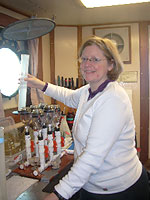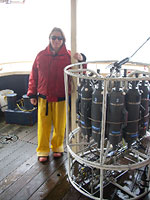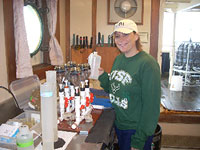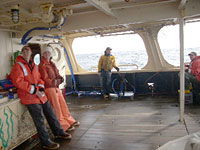

 | |||||||||||||||||||
|
|
Journals 2009/2010Jennifer Duncan
September 14, 2009 Today is the first day to head out into the Gulf of Alaska. The R/V Tiglax crew was so helpful and the scientists were lots of fun and considerate. I really appreciate them accepting a newcomer onboard. Our first station was the Gulf of Alaska, GAK 13, about 130 miles offshore. This was one of the deepest stations, over 1800 meters (5,800 feet). After dressing into our proper deck gear, we began lowering the CTD. This took some time considering how deep it needed to go. When it was brought onboard Katherine showed me how to collect the water samples. Katherine Trahanovsky is a Ph.D. Oceanography student, at University of Alaska at Fairbanks, (UAF). She already has a degree in Chemical Engineering, worked as an environmental engineer, and then as a software engineer, however she has always wanted to study the ocean. She is focusing on nutrients and primary productivity of the Seward Line on this trip.
She uses small bottles to collect water for nutrient analysis such as nitrogen and phosphorous. These are very important to phytoplankton and biological productivity. These bottles were placed in the freezer until she returns to the lab for further evaluation. The large bottles are used to study the amount of chlorophyll at each station. This gives a good indication as to the productivity of the phytoplankton. We first filtered 500 mL of the large water bottles from each depth through a fine (Whatmann) paper filter to obtain an estimate of the total amount of chlorophyll in the sample. She will complete this process back in her lab when she can process these samples through a fluorometer. This will give a rough estimate as to where the most abundant phytoplankton are located. The fractionated (20 micron, 5 micron) filter will give a rough estimate as to the size of the most abundant phytoplankton at the station. Both these processes are time consuming. I helped Katherine as much as I could and she was still working until late in the night time. We had a little ongoing joke, she kept saying "There is only one more to do today." The next day she would say, "only one more." And so on. Luckily, she finished today's samples before the storm reached us. |
||||||||||||||||||



